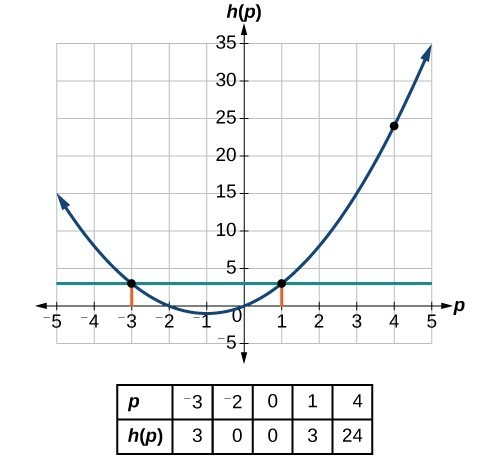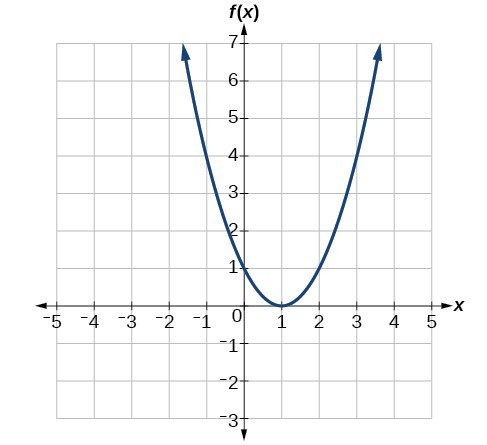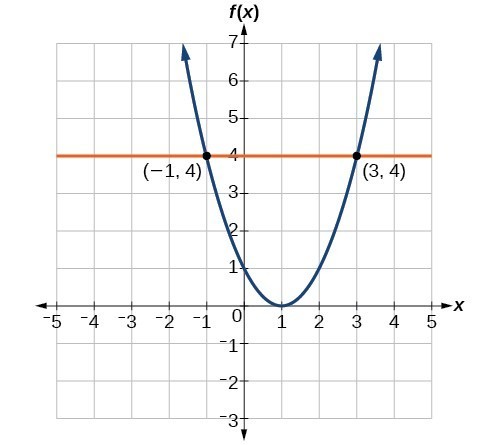Evaluating and Solving Functions
Learning Outcomes
- Evaluate and solve functions in algebraic form.
- Evaluate functions given tabular or graphical data.
How To: EVALUATE A FUNCTION Given ITS FORMula.
- Replace the input variable in the formula with the value provided.
- Calculate the result.
Example: Evaluating Functions
Given the function [latex]h\left(p\right)={p}^{2}+2p[/latex], evaluate [latex]h\left(4\right)[/latex].Answer:
To evaluate [latex]h\left(4\right)[/latex], we substitute the value 4 for the input variable [latex]p[/latex] in the given function.
[latex]\begin{align}h\left(p\right)&={p}^{2}+2p \\ h\left(4\right)&={\left(4\right)}^{2}+2\left(4\right) \\ &=16+8 \\ &=24 \end{align}[/latex]
Therefore, for an input of 4, we have an output of 24 or [latex]h(4)=24[/latex].evaluating functions
When evaluating functions, it's handy to wrap the input variable in parentheses before making the substitution. Ex. Given [latex]f(x)=x^2 - 8[/latex], find [latex]f(-3)[/latex] [latex-display]\begin{align}f(x)&=(x)^2 - 8 \\ &= (-3)^2 - 8 \\ &= 9 - 8 \\ &= 1\end{align}[/latex-display] The value of the function [latex]f(x)=x^2 - 8[/latex], at the input [latex]x=-3[/latex], is [latex]1[/latex].Example: Evaluating Functions at Specific Values
For the function, [latex]f\left(x\right)={x}^{2}+3x - 4[/latex], evaluate each of the following.- [latex]f\left(2\right)[/latex]
- [latex]f(a)[/latex]
- [latex]f(a+h)[/latex]
- [latex]\dfrac{f\left(a+h\right)-f\left(a\right)}{h}[/latex]
Answer: Replace the [latex]x[/latex] in the function with each specified value.
- Because the input value is a number, 2, we can use algebra to simplify.
[latex]\begin{align}f\left(2\right)&={2}^{2}+3\left(2\right)-4 \\ &=4+6 - 4 \\ &=6\hfill \end{align}[/latex]
- In this case, the input value is a letter so we cannot simplify the answer any further.
[latex]f\left(a\right)={a}^{2}+3a - 4[/latex]
- With an input value of [latex]a+h[/latex], we must use the distributive property.
[latex]\begin{align}f\left(a+h\right)&={\left(a+h\right)}^{2}+3\left(a+h\right)-4 \\[2mm] &={a}^{2}+2ah+{h}^{2}+3a+3h - 4 \end{align}[/latex]
- In this case, we apply the input values to the function more than once, and then perform algebraic operations on the result. We already found that
[latex]f\left(a+h\right)={a}^{2}+2ah+{h}^{2}+3a+3h - 4[/latex]and we know that[latex]f\left(a\right)={a}^{2}+3a - 4[/latex]Now we combine the results and simplify.
[latex]\begin{align}\dfrac{f\left(a+h\right)-f\left(a\right)}{h}&=\dfrac{\left({a}^{2}+2ah+{h}^{2}+3a+3h - 4\right)-\left({a}^{2}+3a - 4\right)}{h} \\[2mm] &=\dfrac{2ah+{h}^{2}+3h}{h}\\[2mm] &=\frac{h\left(2a+h+3\right)}{h}&&\text{Factor out }h. \\[2mm] &=2a+h+3&&\text{Simplify}.\end{align}[/latex]
Try It
Given the function [latex]g\left(m\right)=\sqrt{m - 4}[/latex], evaluate [latex]g\left(5\right)[/latex].Answer: [latex-display]g\left(5\right)=\sqrt{5 - 4}=1[/latex-display]
[ohm_question]97486[/ohm_question]Example: Solving Functions
Given the function [latex]h\left(p\right)={p}^{2}+2p[/latex], solve for [latex]h\left(p\right)=3[/latex].Answer:
[latex]\begin{align}&h\left(p\right)=3\\ &{p}^{2}+2p=3 &&\text{Substitute the original function }h\left(p\right)={p}^{2}+2p. \\ &{p}^{2}+2p - 3=0 &&\text{Subtract 3 from each side}. \\ &\left(p+3\text{)(}p - 1\right)=0 &&\text{Factor}. \end{align}[/latex]
If [latex]\left(p+3\right)\left(p - 1\right)=0[/latex], either [latex]\left(p+3\right)=0[/latex] or [latex]\left(p - 1\right)=0[/latex] (or both of them equal 0). We will set each factor equal to 0 and solve for [latex]p[/latex] in each case.[latex]\begin{align}&p+3=0, &&p=-3 \\ &p - 1=0, &&p=1\hfill \end{align}[/latex]
This gives us two solutions. The output [latex]h\left(p\right)=3[/latex] when the input is either [latex]p=1[/latex] or [latex]p=-3[/latex]. We can also verify by graphing as in Figure 5. The graph verifies that [latex]h\left(1\right)=h\left(-3\right)=3[/latex] and [latex]h\left(4\right)=24[/latex].
We can also verify by graphing as in Figure 5. The graph verifies that [latex]h\left(1\right)=h\left(-3\right)=3[/latex] and [latex]h\left(4\right)=24[/latex].
How To: Solve a Function.
- Replace the output in the formula with the value provided.
- Solve for the input variable that makes the statement true.
Try It
Given the function [latex]g\left(m\right)=\sqrt{m - 4}[/latex], solve [latex]g\left(m\right)=2[/latex].Answer: [latex-display]m=8[/latex-display]
[ohm_question]15766[/ohm_question]Evaluating Functions Expressed in Formulas
Some functions are defined by mathematical rules or procedures expressed in equation form. If it is possible to express the function output with a formula involving the input quantity, then we can define a function in algebraic form. For example, the equation [latex]2n+6p=12[/latex] expresses a functional relationship between [latex]n[/latex] and [latex]p[/latex]. We can rewrite it to decide if [latex]p[/latex] is a function of [latex]n[/latex].functions, Equations, and formulas
We've seen that an equation such as [latex]ax+by=c[/latex] can be written in a different form by solving the equation for one of the variables. If we solve this linear equation for y it can be written in the slope-intercept form of a line, [latex]y = mx+b[/latex]. Certain formulas can be written in function form by solving for one of the variables. For instance, can you see how to solve the formula for a rectangle having a perimeter of 21 feet, [latex]21 = 2l + 2w[/latex], for length?Answer: [latex-display]\begin{align} 21 &= 2l + 2w \\ 21 - 2w &= 2l \\ \dfrac{21-2w}{2} &= l \end{align}[/latex-display] We can now declare a function, [latex]l = f(x)[/latex] that returns an output length for a rectangle having a perimeter of 21 feet based on different width inputs.
How To: Given a function in equation form, write its algebraic formula.
- Solve the equation to isolate the output variable on one side of the equal sign, with the other side as an expression that involves only the input variable.
- Use all the usual algebraic methods for solving equations, such as adding or subtracting the same quantity to or from both sides, or multiplying or dividing both sides of the equation by the same quantity.
Example: Finding an Equation of a Function
Express the relationship [latex]2n+6p=12[/latex] as a function [latex]p=f\left(n\right)[/latex], if possible.Answer: To express the relationship in this form, we need to be able to write the relationship where [latex]p[/latex] is a function of [latex]n[/latex], which means writing it as [latex]p=[/latex] expression involving [latex]n[/latex].
[latex]\begin{align}&2n+6p=12\\[1mm] &6p=12 - 2n &&\text{Subtract }2n\text{ from both sides}. \\[1mm] &p=\frac{12 - 2n}{6} &&\text{Divide both sides by 6 and simplify}. \\[1mm] &p=\frac{12}{6}-\frac{2n}{6} \\[1mm] &p=2-\frac{1}{3}n \end{align}[/latex]
Therefore, [latex]p[/latex] as a function of [latex]n[/latex] is written as[latex]p=f\left(n\right)=2-\frac{1}{3}n[/latex]
Analysis of the Solution
It is important to note that not every relationship expressed by an equation can also be expressed as a function with a formula.Example: Expressing the Equation of a Circle as a Function
Does the equation [latex]{x}^{2}+{y}^{2}=1[/latex] represent a function with [latex]x[/latex] as input and [latex]y[/latex] as output? If so, express the relationship as a function [latex]y=f\left(x\right)[/latex].Answer: First we subtract [latex]{x}^{2}[/latex] from both sides.
[latex]{y}^{2}=1-{x}^{2}[/latex]
We now try to solve for [latex]y[/latex] in this equation.[latex]\begin{align}y&=\pm \sqrt{1-{x}^{2}} \\[1mm] &=\sqrt{1-{x}^{2}}\hspace{3mm}\text{and}\hspace{3mm}-\sqrt{1-{x}^{2}} \end{align}[/latex]
We get two outputs corresponding to the same input, so this relationship cannot be represented as a single function [latex]y=f\left(x\right)[/latex].Try It
If [latex]x - 8{y}^{3}=0[/latex], express [latex]y[/latex] as a function of [latex]x[/latex].Answer: [latex]y=f\left(x\right)=\cfrac{\sqrt[3]{x}}{2}[/latex]
[ohm_question]111699[/ohm_question]Q & A
Are there relationships expressed by an equation that do represent a function but which still cannot be represented by an algebraic formula? Yes, this can happen. For example, given the equation [latex]x=y+{2}^{y}[/latex], if we want to express [latex]y[/latex] as a function of [latex]x[/latex], there is no simple algebraic formula involving only [latex]x[/latex] that equals [latex]y[/latex]. However, each [latex]x[/latex] does determine a unique value for [latex]y[/latex], and there are mathematical procedures by which [latex]y[/latex] can be found to any desired accuracy. In this case, we say that the equation gives an implicit (implied) rule for [latex]y[/latex] as a function of [latex]x[/latex], even though the formula cannot be written explicitly.Evaluating a Function Given in Tabular Form
As we saw above, we can represent functions in tables. Conversely, we can use information in tables to write functions, and we can evaluate functions using the tables. For example, how well do our pets recall the fond memories we share with them? There is an urban legend that a goldfish has a memory of 3 seconds, but this is just a myth. Goldfish can remember up to 3 months, while the beta fish has a memory of up to 5 months. And while a puppy’s memory span is no longer than 30 seconds, the adult dog can remember for 5 minutes. This is meager compared to a cat, whose memory span lasts for 16 hours. The function that relates the type of pet to the duration of its memory span is more easily visualized with the use of a table. See the table below.| Pet | Memory span in hours |
|---|---|
| Puppy | 0.008 |
| Adult dog | 0.083 |
| Cat | 16 |
| Goldfish | 2160 |
| Beta fish | 3600 |
How To: Given a function represented by a table, identify specific output and input values.
- Find the given input in the row (or column) of input values.
- Identify the corresponding output value paired with that input value.
- Find the given output values in the row (or column) of output values, noting every time that output value appears.
- Identify the input value(s) corresponding to the given output value.
Example: Evaluating and Solving a Tabular Function
Using the table below,- Evaluate [latex]g\left(3\right)[/latex].
- Solve [latex]g\left(n\right)=6[/latex].
| [latex]n[/latex] | 1 | 2 | 3 | 4 | 5 |
| [latex]g(n)[/latex] | 8 | 6 | 7 | 6 | 8 |
Answer:
- Evaluating [latex]g\left(3\right)[/latex] means determining the output value of the function [latex]g[/latex] for the input value of [latex]n=3[/latex]. The table output value corresponding to [latex]n=3[/latex] is 7, so [latex]g\left(3\right)=7[/latex].
- Solving [latex]g\left(n\right)=6[/latex] means identifying the input values, [latex]n[/latex], that produce an output value of 6. The table below shows two solutions: [latex]n=2[/latex] and [latex]n=4[/latex].
| [latex]n[/latex] | 1 | 2 | 3 | 4 | 5 |
| [latex]g(n)[/latex] | 8 | 6 | 7 | 6 | 8 |
Try It
Using the table from the previous example, evaluate [latex]g\left(1\right)[/latex] .Answer: [latex]g\left(1\right)=8[/latex]
[ohm_question]3751[/ohm_question]Finding Function Values from a Graph
ordered pairs of inputs and outputs
We can view a function as a set of inputs and their corresponding outputs. That is, we can see a function as a set of ordered pairs, [latex]\left(x, y \right).[/latex] Remember that, in function notation, [latex]y = f(x)[/latex], so the ordered pairs containing inputs and outputs can be written in the form of (input, output) or [latex]\left(x, f(x)\right)[/latex].Example: Reading Function Values from a Graph
Given the graph below,- Evaluate [latex]f\left(2\right)[/latex].
- Solve [latex]f\left(x\right)=4[/latex].

Answer:
- To evaluate [latex]f\left(2\right)[/latex], locate the point on the curve where [latex]x=2[/latex], then read the [latex]y[/latex]-coordinate of that point. The point has coordinates [latex]\left(2,1\right)[/latex], so [latex]f\left(2\right)=1[/latex].

- To solve [latex]f\left(x\right)=4[/latex], we find the output value [latex]4[/latex] on the vertical axis. Moving horizontally along the line [latex]y=4[/latex], we locate two points of the curve with output value [latex]4:[/latex] [latex]\left(-1,4\right)[/latex] and [latex]\left(3,4\right)[/latex]. These points represent the two solutions to [latex]f\left(x\right)=4:[/latex] [latex]x=-1[/latex] or [latex]x=3[/latex]. This means [latex]f\left(-1\right)=4[/latex] and [latex]f\left(3\right)=4[/latex], or when the input is [latex]-1[/latex] or [latex]\text{3,}[/latex] the output is [latex]\text{4}\text{.}[/latex] See the graph below.

Try It
Using the graph, solve [latex]f\left(x\right)=1[/latex].
Answer: [latex-display]x=0[/latex] or [latex]x=2[/latex-display]
[ohm_question]2471[/ohm_question] [ohm_question]2886[/ohm_question]Try It
You can use an online graphing calculator to graph functions, find function values, and evaluate functions. Watch this short tutorial to learn how to within Desmos. Other online graphing tools will be slightly different. https://youtu.be/jACDzJ-rmsM Now try the following with an online graphing calculator:- Graph the function [latex]f(x) = -\frac{1}{2}x^2+x+4[/latex] using function notation.
- Evaluate the function at [latex]x=1[/latex]
- Make a table of values that references the function. Include at least the interval [latex][-5,5][/latex] for [latex]x[/latex]-values.
- Solve the function for [latex]f(0)[/latex]
Licenses & Attributions
CC licensed content, Original
- Revision and Adaptation. Provided by: Lumen Learning License: CC BY: Attribution.
- Question ID 111699. Provided by: Lumen Learning License: CC BY: Attribution. License terms: IMathAS Community License CC-BY + GPL.
CC licensed content, Shared previously
- College Algebra. Provided by: OpenStax Authored by: Abramson, Jay et al.. Located at: https://openstax.org/books/college-algebra/pages/1-introduction-to-prerequisites. License: CC BY: Attribution. License terms: Download for free at http://cnx.org/contents/[email protected].
- Learn Desmos: Functions. License: All Rights Reserved. License terms: Standard YouTube License.
- Question ID 1647. Authored by: WebWork-Rochester, mb Lippman,David, mb Sousa,James. License: CC BY: Attribution. License terms: IMathAS Community License CC-BY + GPL.
- Question ID 97486. Authored by: Carmichael,Patrick. License: CC BY: Attribution. License terms: IMathAS Community License CC-BY + GPL.
- Question ID 15766, 2886. Authored by: Lippman,David. License: CC BY: Attribution. License terms: IMathAS Community License CC-BY + GPL.
- Question ID 3751. Authored by: Lippman, David. License: CC BY: Attribution. License terms: IMathAS Community License CC-BY + GPL.
- Question ID 2471. Authored by: Greg Langkamp. License: CC BY: Attribution. License terms: IMathAS Community License CC-BY + GPL.

